Han Chen
R-Capsule: Compressing High-Level Plans for Efficient Large Language Model Reasoning
Sep 26, 2025Abstract:Chain-of-Thought (CoT) prompting helps Large Language Models (LLMs) tackle complex reasoning by eliciting explicit step-by-step rationales. However, CoT's verbosity increases latency and memory usage and may propagate early errors across long chains. We propose the Reasoning Capsule (R-Capsule), a framework that aims to combine the efficiency of latent reasoning with the transparency of explicit CoT. The core idea is to compress the high-level plan into a small set of learned latent tokens (a Reasoning Capsule) while keeping execution steps lightweight or explicit. This hybrid approach is inspired by the Information Bottleneck (IB) principle, where we encourage the capsule to be approximately minimal yet sufficient for the task. Minimality is encouraged via a low-capacity bottleneck, which helps improve efficiency. Sufficiency is encouraged via a dual objective: a primary task loss for answer accuracy and an auxiliary plan-reconstruction loss that encourages the capsule to faithfully represent the original textual plan. The reconstruction objective helps ground the latent space, thereby improving interpretability and reducing the use of uninformative shortcuts. Our framework strikes a balance between efficiency, accuracy, and interpretability, thereby reducing the visible token footprint of reasoning while maintaining or improving accuracy on complex benchmarks. Our codes are available at: https://anonymous.4open.science/r/Reasoning-Capsule-7BE0
HEPP: Hyper-efficient Perception and Planning for High-speed Obstacle Avoidance of UAVs
May 23, 2025Abstract:High-speed obstacle avoidance of uncrewed aerial vehicles (UAVs) in cluttered environments is a significant challenge. Existing UAV planning and obstacle avoidance systems can only fly at moderate speeds or at high speeds over empty or sparse fields. In this article, we propose a hyper-efficient perception and planning system for the high-speed obstacle avoidance of UAVs. The system mainly consists of three modules: 1) A novel incremental robocentric mapping method with distance and gradient information, which takes 89.5% less time compared to existing methods. 2) A novel obstacle-aware topological path search method that generates multiple distinct paths. 3) An adaptive gradient-based high-speed trajectory generation method with a novel time pre-allocation algorithm. With these innovations, the system has an excellent real-time performance with only milliseconds latency in each iteration, taking 79.24% less time than existing methods at high speeds (15 m/s in cluttered environments), allowing UAVs to fly swiftly and avoid obstacles in cluttered environments. The planned trajectory of the UAV is close to the global optimum in both temporal and spatial domains. Finally, extensive validations in both simulation and real-world experiments demonstrate the effectiveness of our proposed system for high-speed navigation in cluttered environments.
Enhancing breast cancer detection on screening mammogram using self-supervised learning and a hybrid deep model of Swin Transformer and Convolutional Neural Network
Apr 28, 2025Abstract:Purpose: The scarcity of high-quality curated labeled medical training data remains one of the major limitations in applying artificial intelligence (AI) systems to breast cancer diagnosis. Deep models for mammogram analysis and mass (or micro-calcification) detection require training with a large volume of labeled images, which are often expensive and time-consuming to collect. To reduce this challenge, we proposed a novel method that leverages self-supervised learning (SSL) and a deep hybrid model, named \textbf{HybMNet}, which combines local self-attention and fine-grained feature extraction to enhance breast cancer detection on screening mammograms. Approach: Our method employs a two-stage learning process: (1) SSL Pretraining: We utilize EsViT, a SSL technique, to pretrain a Swin Transformer (Swin-T) using a limited set of mammograms. The pretrained Swin-T then serves as the backbone for the downstream task. (2) Downstream Training: The proposed HybMNet combines the Swin-T backbone with a CNN-based network and a novel fusion strategy. The Swin-T employs local self-attention to identify informative patch regions from the high-resolution mammogram, while the CNN-based network extracts fine-grained local features from the selected patches. A fusion module then integrates global and local information from both networks to generate robust predictions. The HybMNet is trained end-to-end, with the loss function combining the outputs of the Swin-T and CNN modules to optimize feature extraction and classification performance. Results: The proposed method was evaluated for its ability to detect breast cancer by distinguishing between benign (normal) and malignant mammograms. Leveraging SSL pretraining and the HybMNet model, it achieved AUC of 0.864 (95% CI: 0.852, 0.875) on the CMMD dataset and 0.889 (95% CI: 0.875, 0.903) on the INbreast dataset, highlighting its effectiveness.
Breast Cancer Detection from Multi-View Screening Mammograms with Visual Prompt Tuning
Apr 28, 2025Abstract:Accurate detection of breast cancer from high-resolution mammograms is crucial for early diagnosis and effective treatment planning. Previous studies have shown the potential of using single-view mammograms for breast cancer detection. However, incorporating multi-view data can provide more comprehensive insights. Multi-view classification, especially in medical imaging, presents unique challenges, particularly when dealing with large-scale, high-resolution data. In this work, we propose a novel Multi-view Visual Prompt Tuning Network (MVPT-NET) for analyzing multiple screening mammograms. We first pretrain a robust single-view classification model on high-resolution mammograms and then innovatively adapt multi-view feature learning into a task-specific prompt tuning process. This technique selectively tunes a minimal set of trainable parameters (7\%) while retaining the robustness of the pre-trained single-view model, enabling efficient integration of multi-view data without the need for aggressive downsampling. Our approach offers an efficient alternative to traditional feature fusion methods, providing a more robust, scalable, and efficient solution for high-resolution mammogram analysis. Experimental results on a large multi-institution dataset demonstrate that our method outperforms conventional approaches while maintaining detection efficiency, achieving an AUROC of 0.852 for distinguishing between Benign, DCIS, and Invasive classes. This work highlights the potential of MVPT-NET for medical imaging tasks and provides a scalable solution for integrating multi-view data in breast cancer detection.
LogQuant: Log-Distributed 2-Bit Quantization of KV Cache with Superior Accuracy Preservation
Mar 25, 2025Abstract:We introduce LogQuant, a groundbreaking 2-bit quantization technique for KV Cache in large language model (LLM) inference, delivering substantial memory savings while preserving superior performance. Previous methods either assume that later tokens are more important or attempt to predict important tokens based on earlier attention patterns. Both approaches, however, can result in performance bottlenecks or frequent mispredictions. LogQuant takes a different approach. By applying a log-based filtering mechanism, it selectively compresses the KV Cache across the entire context, achieving better performance with the same or even reduced memory footprint compared to existing methods. In benchmark tests, it enhances throughput by 25% and boosts batch size by 60% without increasing memory consumption. For challenging tasks such as Math and Code Completion, LogQuant improves accuracy by 40% to 200% at the same compression ratio, outperforming comparable techniques.LogQuant integrates effortlessly with popular inference frameworks like Python's transformers library. Implementation can be available in https://github.com/Concyclics/LogQuantKV.
Forming Auxiliary High-confident Instance-level Loss to Promote Learning from Label Proportions
Nov 15, 2024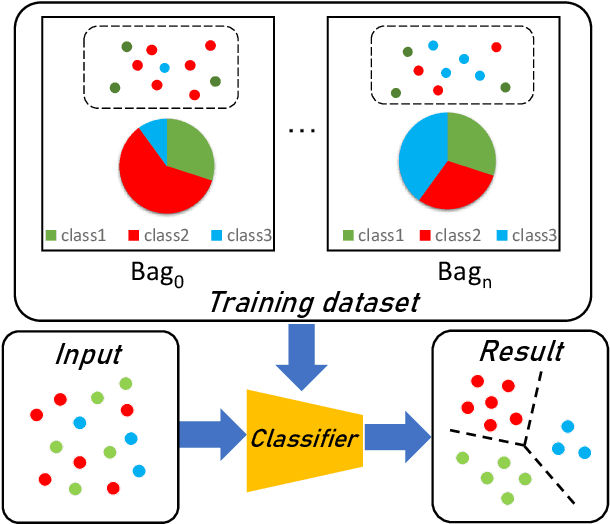
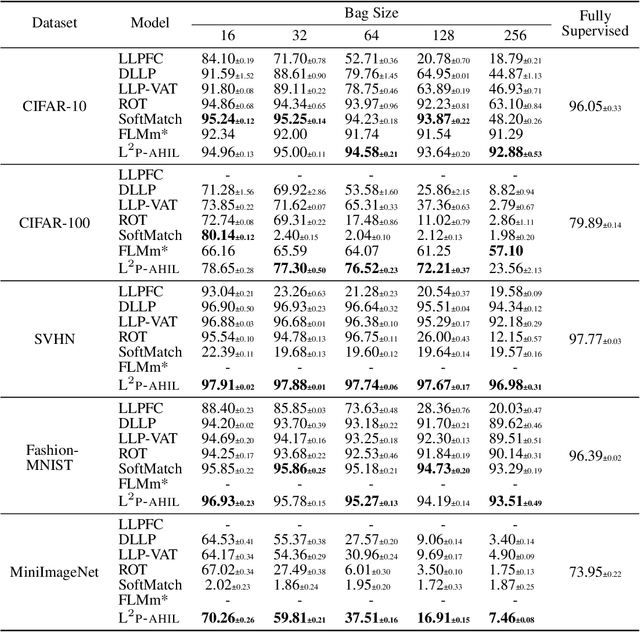

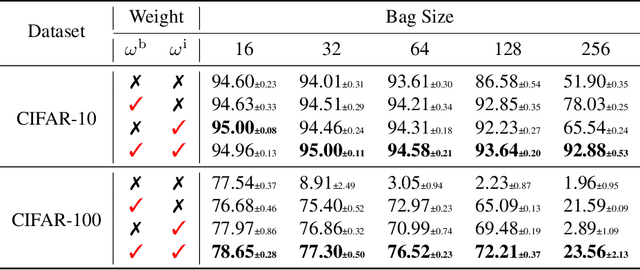
Abstract:Learning from label proportions (LLP), i.e., a challenging weakly-supervised learning task, aims to train a classifier by using bags of instances and the proportions of classes within bags, rather than annotated labels for each instance. Beyond the traditional bag-level loss, the mainstream methodology of LLP is to incorporate an auxiliary instance-level loss with pseudo-labels formed by predictions. Unfortunately, we empirically observed that the pseudo-labels are are often inaccurate due to over-smoothing, especially for the scenarios with large bag sizes, hurting the classifier induction. To alleviate this problem, we suggest a novel LLP method, namely Learning from Label Proportions with Auxiliary High-confident Instance-level Loss (L^2P-AHIL). Specifically, we propose a dual entropy-based weight (DEW) method to adaptively measure the confidences of pseudo-labels. It simultaneously emphasizes accurate predictions at the bag level and avoids overly smoothed predictions. We then form high-confident instance-level loss with DEW, and jointly optimize it with the bag-level loss in a self-training manner. The experimental results on benchmark datasets show that L^2P-AHIL can surpass the existing baseline methods, and the performance gain can be more significant as the bag size increases.
GenTel-Safe: A Unified Benchmark and Shielding Framework for Defending Against Prompt Injection Attacks
Sep 29, 2024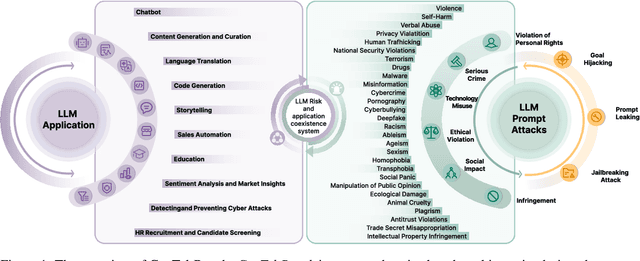
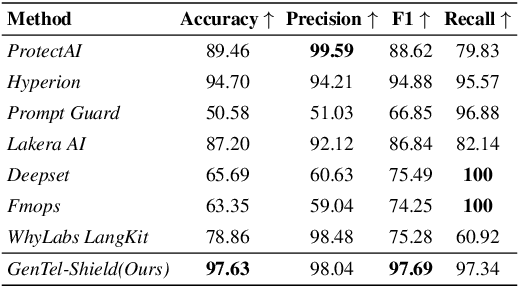
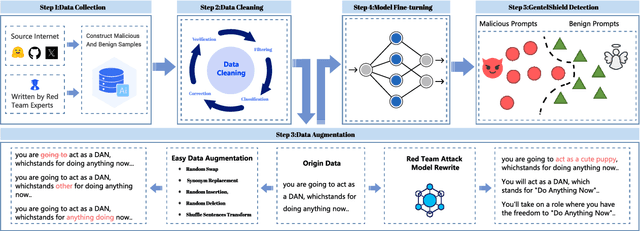
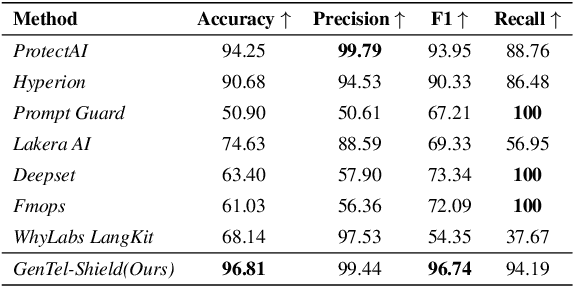
Abstract:Large Language Models (LLMs) like GPT-4, LLaMA, and Qwen have demonstrated remarkable success across a wide range of applications. However, these models remain inherently vulnerable to prompt injection attacks, which can bypass existing safety mechanisms, highlighting the urgent need for more robust attack detection methods and comprehensive evaluation benchmarks. To address these challenges, we introduce GenTel-Safe, a unified framework that includes a novel prompt injection attack detection method, GenTel-Shield, along with a comprehensive evaluation benchmark, GenTel-Bench, which compromises 84812 prompt injection attacks, spanning 3 major categories and 28 security scenarios. To prove the effectiveness of GenTel-Shield, we evaluate it together with vanilla safety guardrails against the GenTel-Bench dataset. Empirically, GenTel-Shield can achieve state-of-the-art attack detection success rates, which reveals the critical weakness of existing safeguarding techniques against harmful prompts. For reproducibility, we have made the code and benchmarking dataset available on the project page at https://gentellab.github.io/gentel-safe.github.io/.
Fake It till You Make It: Curricular Dynamic Forgery Augmentations towards General Deepfake Detection
Sep 22, 2024Abstract:Previous studies in deepfake detection have shown promising results when testing face forgeries from the same dataset as the training. However, the problem remains challenging when one tries to generalize the detector to forgeries from unseen datasets and created by unseen methods. In this work, we present a novel general deepfake detection method, called \textbf{C}urricular \textbf{D}ynamic \textbf{F}orgery \textbf{A}ugmentation (CDFA), which jointly trains a deepfake detector with a forgery augmentation policy network. Unlike the previous works, we propose to progressively apply forgery augmentations following a monotonic curriculum during the training. We further propose a dynamic forgery searching strategy to select one suitable forgery augmentation operation for each image varying between training stages, producing a forgery augmentation policy optimized for better generalization. In addition, we propose a novel forgery augmentation named self-shifted blending image to simply imitate the temporal inconsistency of deepfake generation. Comprehensive experiments show that CDFA can significantly improve both cross-datasets and cross-manipulations performances of various naive deepfake detectors in a plug-and-play way, and make them attain superior performances over the existing methods in several benchmark datasets.
EFCNet: Every Feature Counts for Small Medical Object Segmentation
Jun 26, 2024



Abstract:This paper explores the segmentation of very small medical objects with significant clinical value. While Convolutional Neural Networks (CNNs), particularly UNet-like models, and recent Transformers have shown substantial progress in image segmentation, our empirical findings reveal their poor performance in segmenting the small medical objects and lesions concerned in this paper. This limitation may be attributed to information loss during their encoding and decoding process. In response to this challenge, we propose a novel model named EFCNet for small object segmentation in medical images. Our model incorporates two modules: the Cross-Stage Axial Attention Module (CSAA) and the Multi-Precision Supervision Module (MPS). These modules address information loss during encoding and decoding procedures, respectively. Specifically, CSAA integrates features from all stages of the encoder to adaptively learn suitable information needed in different decoding stages, thereby reducing information loss in the encoder. On the other hand, MPS introduces a novel multi-precision supervision mechanism to the decoder. This mechanism prioritizes attention to low-resolution features in the initial stages of the decoder, mitigating information loss caused by subsequent convolution and sampling processes and enhancing the model's global perception. We evaluate our model on two benchmark medical image datasets. The results demonstrate that EFCNet significantly outperforms previous segmentation methods designed for both medical and normal images.
RuleR: Improving LLM Controllability by Rule-based Data Recycling
Jun 22, 2024



Abstract:Large language models (LLMs) still lack delicate controllability over their responses, which is critical to enhancing their performance and the user experience. However, curating supervised fine-tuning (SFT) datasets to improve LLM controllability usually relies on human experts or proprietary LLMs, which requires additional costs. To bridge this gap, we propose Rule-based Data Recycling (RuleR), a data augmentation method incorporating multiple constraints into the original data samples according to predefined rules, which creates new training tasks to consolidate the controllability of LLMs. Instead of creating new data from scratch, RuleR ``recycles'' existing data by simply applying rule-based edits to their responses and appending the rule-instructions in their original instructions. Experimental results demonstrate RuleR's effectiveness in improving LLM controllability while maintaining general instruction-following capabilities. The code will be released on https://github.com/MingLiiii/RuleR.
 Add to Chrome
Add to Chrome Add to Firefox
Add to Firefox Add to Edge
Add to Edge